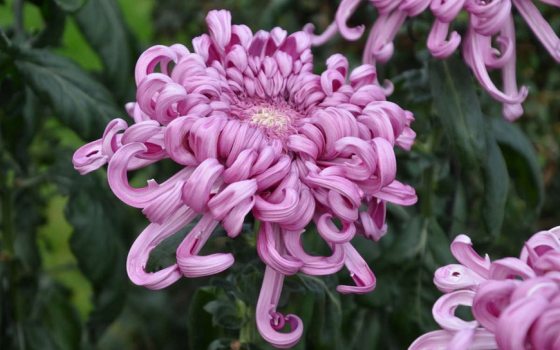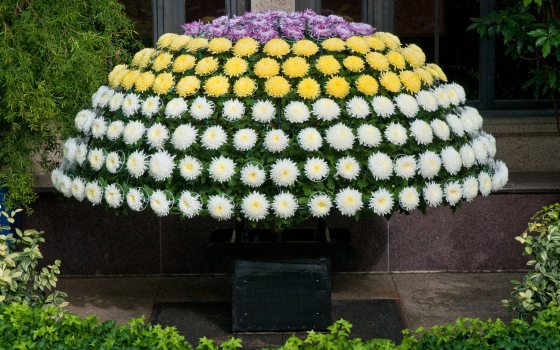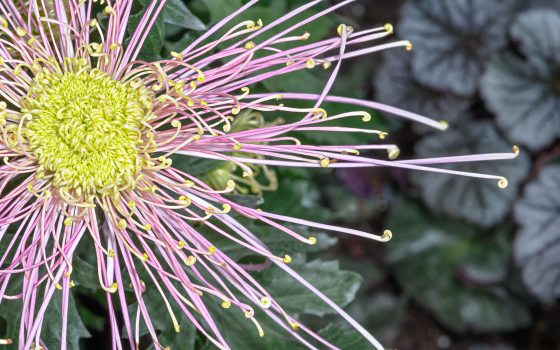Here at Longwood, we always look forward to our annual Chrysanthemum Festival for so many reasons … it’s a chance for us not only to put on a colorful show of rare and beloved cultivars, but also a way for us to stretch our horticultural limits and proudly share with you the fruits of that labor. We take more than a year to prepare for each Chrysanthemum Festival, growing and nurturing our large specialty chrysanthemums into imaginative shapes and forms, all the while caring for a variety of chrysanthemum cultivars … all requiring constant attention. While this year has most definitely thrown us some curveballs—from changing how we had to work to having to reduce the number of Horticulture team members able to work on-site—the challenges of this year have not thrown us off of our horticultural game … and we’re are beyond excited to share this year’s display with you (including an all-new feature!).
As in years past, our Thousand Bloom Chrysanthemum—one of our most prized horticultural achievements—is taking center stage. This single chrysanthemum plant, grown over a period of 17 months and more than 2,000 staff hours to reach its astounding size of 12 feet wide and 8 feet tall, features 1,362 sunny yellow, uniform Chrysanthemum x morifolium ‘Susono-no-Hikari’ blooms. To create the Thousand Bloom Chrysanthemum, we follow a precise technique that originated in China and expanded to Japan several hundred years ago, to cultivate a single chrysanthemum plant to produce as many perfectly placed blooms as possible.
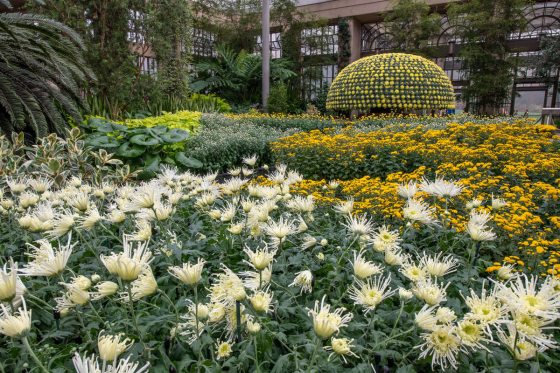
Known in Japan as Ozukuri, this technique requires only a single bloom on the end of each individual branch, meaning none of the flowers on the sides of the branch can be used to create this enormous shape. As buds begin to form, we disbud the mums, which involves taking all of the smaller side buds off and allowing only the main center bud to continue to grow. As the plant grows, it requires meticulous pinching (or removing the shoot tip), which helps new branches form below the pinch, as well as tying the plant to its framework. Throughout the process, our staff disbudded nearly 10,000 tiny flower buds in order to have just one perfect large bloom on each stem.
About a month before the beginning of each Chrysanthemum Festival, we begin final flower placement in the custom-made dome-shaped frame, arranging the flowers to make sure each row is placed perfectly in concentric rings, and each flower is placed in a support to properly position it. After we complete the process of placing the flowers, we can answer just how many blooms we achieved. And yes … our team has already started training the Thousand Bloom plant for next year’s display.
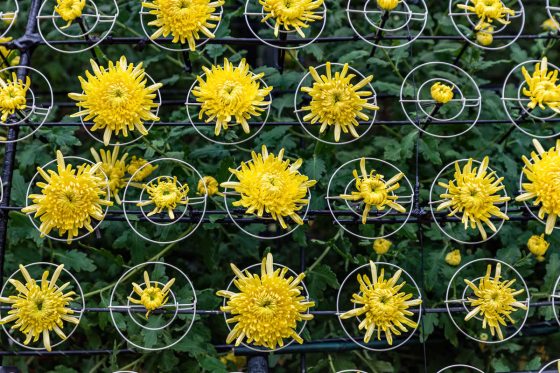
In addition to our Thousand Bloom beauty, this year our horticulturists have grown cascade chrysanthemums into unique three-dimensional forms, including shield, fan, tree, spiral, and cloud forms, among others. We use cascade chrysanthemums for our forms because of their flexibility and ability to grow lengthy stems. These exhibition-style mums require a lot of attention and our team must be diligent in their care. As just one example, our spiral form of Chrysanthemum x morifolium ‘Megumi’ in the Exhibition Hall requires our staff to train chrysanthemums up along the spiral form. Often, the branches coming off the main stem need to be bent sharply in order to conform to the spiral frame, so our staff must first allow the plants to wilt and then break the internal part of the plant. The resulting flexibility allows us to get the branch going in the right direction and set the plant to the frame with wire.
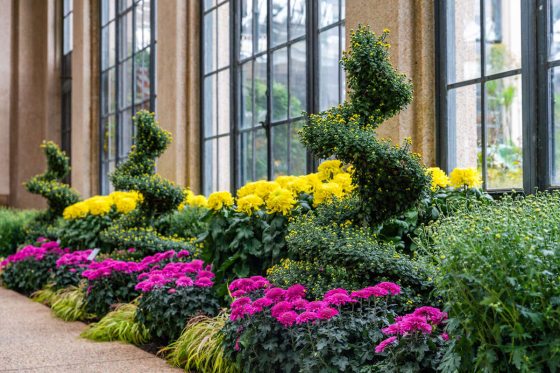
Beginning more than a year before the start of the next Chrysanthemum Festival, our team makes final cultivar choices for the following year and plans out what stock plants are needed. Each of these meticulously nurtured cascade forms start in our production greenhouses in the form of stock plants, where they stay for several months. We take cuttings from those stock plants each December prior to Chrysanthemum Festival. Throughout the late spring and summer, our horticulturists hand-pinch and shear the plants to create multiple buds and multiple flowers per stem. The cascade chrysanthemums typically grow 2 to 4 inches per week, and each pinch creates two more new stems, which leads to a fuller plant and more flower buds … and eventually its resulting form. The forms are exceptionally labor-intensive and, despite all of our challenges this past year, our team came through with shining colors.
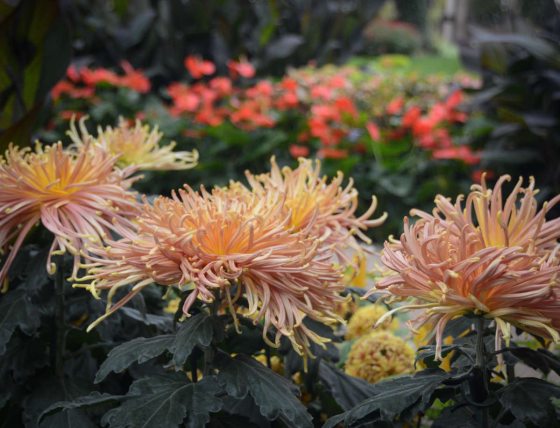
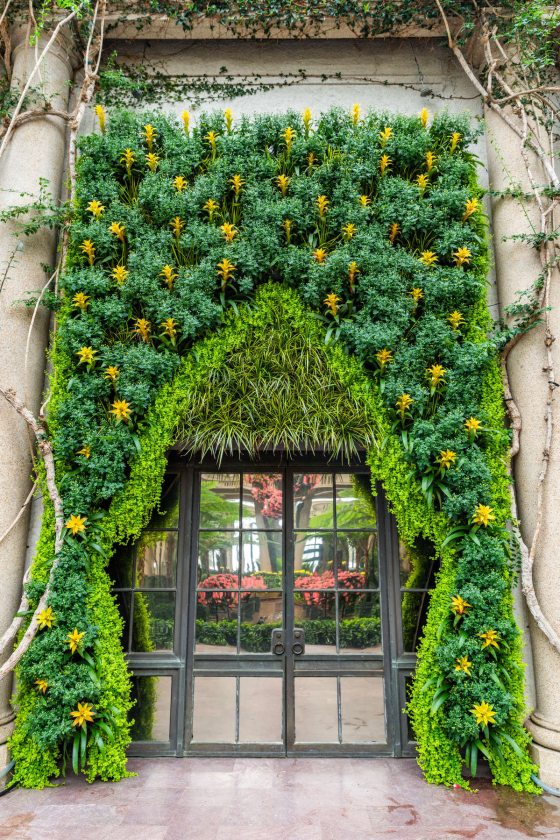
Beyond our iconic Thousand Bloom Chrysanthemum and cascade chrysanthemum forms, Chrysanthemum Festival is known for its display of all 13 chrysanthemum classifications, each representing a distinct flower form with such names as thistle, spoon, spider, and quill. You can see all 13 classifications together in one place by visiting our Fern Passage, where we showcase and identify an example of each.
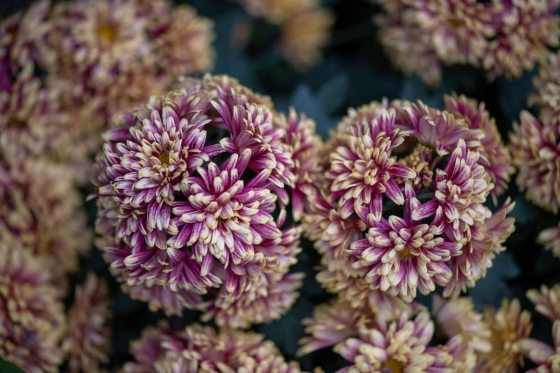
The exhibition mums in our planting beds showcase the qualities of each cultivar. Similar to the cascade growing techniques we use for our forms, our team prunes, pinches, and disbuds the mums you see in the beds to encourage larger flower sizes and more spectacular blooms. By disbudding, all of the plant’s energy is directed to a single flower.
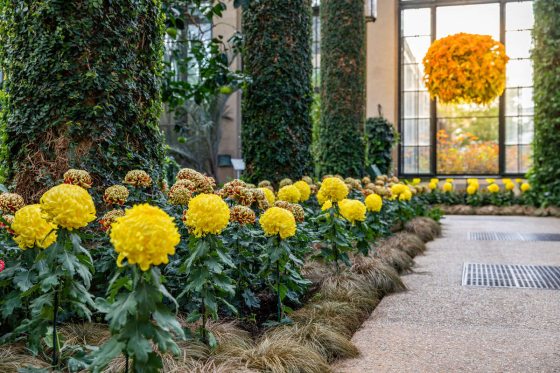
You’ll also see horticultural artistry in the form of our bonsai chrysanthemum display. Averaging about 9 months old, these tiny wonders are created with a variety of training techniques, including root and top pruning, wiring of stems to create the desired style, and frequent pinching.
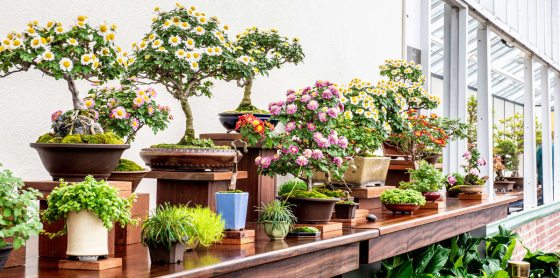
Ranging in size and color, the beautiful chrysanthemums on display during Chrysanthemum Festival help represent our collection of 215 cultivars, which is one of the oldest and largest collections of its kind in North America. Thanks to the hard work of our Research and Conservation team, which maintains our own stock in pots and through tissue culture (housed in more than 1,500 test tubes!), and the unwavering work of our entire Horticulture team, our annual display is made possible year after year.
You’ll find plenty of beauty, plenty of color, and plenty of horticultural wow moments (I’ve only covered a fraction of them here!) throughout Chrysanthemum Festival, on view now through November 15.
